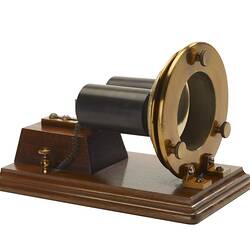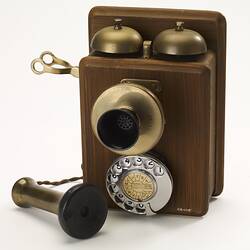Museums Victoria houses an original Harmonic Telegraph Receiver (1875) and Centennial Phone (1876) that were developed by the inventor of the telephone, Alexander Graham Bell (1847-1922). Both devices were built in Bell's workshop in Boston and were brought to Australia by his uncle, E. S. Symonds. They remained in a private collection in Western Australia before being donated to Museum Victoria in 1990.
Alexander Graham Bell
Bell's success with the telephone came as a direct result of his early interest in the formation of sounds and his attempts to improve the telegraph. Bell attended Edinburgh University and began his career as a teacher of elocution to the deaf in various British Schools. In 1871 he moved to the United States and accepted a professorship in Vocal Physiology at Boston University. He commenced experiments with his harmonic or multiple telegraph and conceived the idea for sending speech over an electric wire.
The harmonic telegraph
Bell believed it was possible to convey several notes simultaneously, each at a different pitch, along a telegraph wire. His harmonic telegraph consisted of a series of metallic reeds, vibrating at different frequencies through an armature (protective covering). The arrangement was placed near an electromagnet with the coil attached to a transmission line. At the receiving end a series of tuned reeds was placed near a set of electromagnets, each hooked to the line.
During experiments with three harmonic telegraphs, Bell concluded that the harmonic telegraphy was too feeble to be useful for speech transmission.
The dead man's ear
Bell found the key to the working telephone in a private study of the human ear. An ear was removed from the head of a dead man, together with the ear drum and associated bones. Bell arranged the fragment of skull so that a straw touched the ear drum at one end and a piece of moving smoked glass at the other. When Bell spoke loudly into the ear, the vibrations of the drum made tiny markings on the glass. Bell was struck by the small and thin nature of the ear drum, and how effectively it could send trills and vibrations through heavy bones. He immediately envisaged the membrane telephone in which two iron discs (equivalent to the ear drums) far apart and connected by an electrified wire, caught the vibrations of sound at one end, and reproduced them at the other.
The world's first phone call
On 10 March 1876, Bell successfully transmitted the first words ever uttered on a telephone. He said, 'Mr. Watson, come here, I want you.' Bell's assistant, Thomas A Watson, was at the lower end of the wire, in the basement. He dropped the receiver and rushed up the three flights of stairs to inform Bell of the good news: 'I can hear you! I can hear the words!'.
The Centennial phone
After a few alterations, Bell took models of his telephone to the Centennial Exhibition in Philadelphia on 25 June 1876. The device used an induction transmitter and could act as either a transmitter or a receiver. Having entered at the last moment, Bell failed to obtain a booth in the Electrical section. Instead, he was located far away, in a corner of the educational exhibit. It was a hot day and the judges did not relish the long trip down the corridor and up a flight of stairs. Their fatigue vanished with the first words that came crackling over the telephone wire. Pandemonium broke out as these distinguished scientists, as well as ordinary citizens raced to see if Bell's voice in another room had indeed produced the sounds. Mistaking the purpose of the device, one audience member asked, 'Who will be the next president?'.
Bell demonstrated his invention to astonished crowds around the United States. He formed the Bell Telephone Company and began selling his telephones in early 1877.
The telephone arrives in Australia
Australian inventors were keen to experiment with Bell's new device. One of the country's most versatile innovators was Henry Sutton (1856-1912) of Ballarat, Victoria. By late 1877 Sutton had developed numerous telephonic devices, and 16 of his models were later patented overseas. His work was acknowledged by Alexander Bell during his visit to Australia in 1910. The first telephone service in Australia is believed to have run on 2 January 1878. It operated between hardware supplier McLean Bros & Rigg in Elizabeth Street, Melbourne, and their Spencer Street Depot, over a kilometre away.
References:
Grosvenor, E. 1997. Alexander Graham Bell. Harry Abrams, New York.
Moyal, A. 1988. Clear Across Australia. Thomas Nelson, Melbourne.
More Information
-
Keywords
-
Authors
-
Article types



